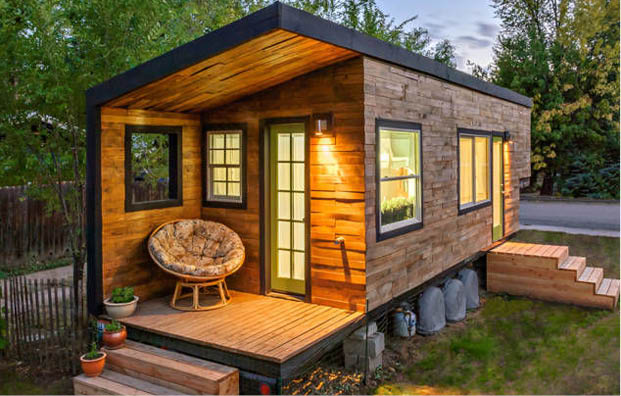Many people downsize when they move to a retirement home. Bette Presley, 72, took that idea to an extreme last year when she moved into her tiny house – a 166-square-foot cabin in the small coastal town of Arroyo Grande, California.
Presley’s home measures just eight by twenty-four feet. It has a built-in platform bed, built-in shelves, space for a narrow table and a loft that accommodates a queen-sized mattress for guests. Her tiny house’s kitchenette is outfitted with a built-in stove and oven, plus a sink and small refrigerator; in the bathroom are a tiny sink, a toilet and a shower. Presley heats and cools her home via a unit on the ceiling.
“We are consumers. We buy too much. We don’t need all of our belongings,” Presley said. “I just experienced the clutter, to live in excess, and I didn’t find it particularly satisfying.”
Presley is part of the Tiny House movement, whose growing popularity reflects a desire among some Americans to pare down, consume less and enjoy a simpler, more customized home and lifestyle. While the houses are small – any home of less than 1,000 square feet is officially “tiny,” but most range between 100 and 400 – the trend is growing fast; as of last month, there’s even a tiny house TV show: Tiny House Builders premiered on HGTV on December 14.
The Tiny House Movement’s growth is largely among the young and child-free, but it’s gaining momentum among seniors, too; some 40 percent of tiny house owners are over age 50. After all, what better time to downsize, personalize, simplify and save – either alone or by buying a plot with friends and forming a tiny house community? A finished build-it-yourself house averages around $23,000, and plans and kits are available online. To have a house custom built runs around $50,000-$60,000. That’s a few hundred thousand less than a tiny Manhattan apartment and an alternative to a Florida condo.
Tiny houses are for sale in nearly every state and in general, tiny house builders will ship a completed house almost anywhere. Most tinies are located in scenic rural settings, but there are appealing micro-apartments and mini-houses for urban dwellers, too. Currently the only tiny house showcase, Micro Showcase, is located in urban Washington DC (top photo), and in 2010 MEKA, a company that creates modular living solutions and ships them worldwide, dropped a 320-square-foot MEKA show home with a shipping container shell in the middle of NYC’s West Village.
House styles are limited only by square footage and your imagination – super mod, industrial chic, rustic, luxe or any quirky mashup that suits your personal needs and aesthetic.
Whatever the style, your house – like Presley’s – is likely to incorporate space-saving innovations in cabinetry, appliances and furnishings borrowed from the boat and RV industries. Although the company Tiny Home Builders has a Tiny Retirement design that does away with loft beds and ladders, we haven’t yet seen fully accessible tiny houses built with universal design principals, but these are surely coming.
Why Go Tiny?
Tiny home dwellers enjoy these benefits compared to traditional housing:
Cut your expenses and debt Costs of building or buying a home, utilities, taxes, repairs and maintenance all decrease. Sixty-eight percent of tiny-house dwellers have no mortgage.
Have greater freedom Fewer possessions, greater mobility, more time (and money) to spend on favorite activities or traveling to visit family and friends, more time out in the community using resources like libraries, the local “Y” and gyms.
Be adaptable A truly tiny house is mobile. If down the road you decide it’s time to live closer to family members, you can take your home and plop it in the yard, a ready-made granny-pod (of course you’ll need to hook up utilities).
Reduce your environmental footprint Building tiny means less waste of natural resources, reduces energy and water use, and often uses high-quality green building materials.
Grow better relationships People who share their tiny homes with a partner find that living in a small space breeds more open communication, understanding and patience. For some, going tiny is a way of living a more sustainable lifestyle.
Drawbacks to Tiny Living
It’s hard to downsize Not everyone is ready to cut way back on what they own. Will you be able to part with your keepsakes and heirlooms?
Codes and permits can be tricky Cities make less tax revenue from tiny houses, so they are not welcome everywhere; building codes vary from city to city and most tiny homeowners have a hard time getting city permits; in January 2015, seniors Karen and Tom Rogers won a board of zoning appeal in York County, PA to keep their 565-square-foot tiny house; the decision is being reconsidered.
Tiny homes are frequently built on wheels and registered through the DMV as RV’s, semi-trailers or mobile homes, which don’t have to go through the same zoning or permitting process. Read more here.
Lifestyle changes can be wrenching Want to try before you buy? Tiny house vacation rentals are available in most states and can be found with some quick online research. In July 2013, the first-of-its-kind Caravan Tiny House Hotel opened in Portland, OR, comprised of six tinies for rent individually or for groups of 20 if rented all together.
Almost 60 percent of people 55+ say “No Way” to the idea of living in a tiny house; some 15 percent are interested or enthusiastic. A discussion on Yahoo in answer to the question, “Can seniors build and live in tiny houses for the rest of their lives” surfaced a range of opinions – including one from a commenter who cited a neighbor’s experience: “[He] sold his suburban home at the age of 67 to build a tiny house for himself measuring a little less than 500 sq ft (the typical upper limit for a small home). That house lasted him till the age of 82.”












